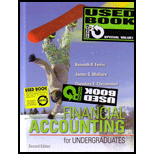
Concept explainers
a. 1.
Calculate the
a. 1.
Explanation of Solution
Depreciation expense:
Depreciation expense is a non-cash expense, which is recorded on the income statement reflecting the consumption of economic benefits of long-term asset on account of its wear and tear or obsolescence.
Straight-line depreciation method:
The depreciation method which assumes that the consumption of economic benefits of long-term asset could be distributed equally throughout the useful life of the asset is referred to as straight-line method.
Compute the depreciation expense of machine per year using straight-line method.
The depreciation expense under the straight-line method is same for every year. Hence, $32,550 is the depreciation expense of the machine for all the four years 2012-2017.
a. 2.
Calculate the depreciation expense of the machine’s useful life for the period 2012-2017 under the double-declining balance method.
a. 2.
Explanation of Solution
Double-declining-balance method:
The depreciation method which assumes that the consumption of economic benefits of long-term asset is high in the early years but gradually declines towards the end of its useful life is referred to as double-declining-balance method.
Compute the depreciation expense of machine as on January 2, 2013 using double-declining balance method.
Compute the depreciation expense of machine as on January 2, 2014 using double-declining balance method.
Compute the depreciation expense of machine as on January 2, 2015 using double-declining balance method.
Compute the depreciation expense of machine as on January 2, 2016 using double-declining balance method.
Compute the depreciation expense of machine as on January 2, 2017 using double-declining balance method.
Working Note:
Compute the depreciation rate applied each year.
Useful life = 6 years
Note: Use 100% to represent depreciation in percentage. Multiply the depreciation rate with 2 as it is a double-declining method.
a. 3.
Calculate the depreciation expense of the machine’s useful life for the period 2012-2017 under the units-of-production balance method.
a. 3.
Explanation of Solution
Units-of-production method:
The depreciation method which assumes that the consumption of economic benefits of long-term asset is based on the production capacity or output is referred to as units-of-production method.
Compute the depreciation expense of machine for the year 2012 using units-of-production method.
Compute the depreciation expense of machine for the year 2013 using units-of-production method.
Compute the depreciation expense of machine for the year 2014 using units-of-production method.
Compute the depreciation expense of machine for the year 2015 using units-of-production method.
Compute the depreciation expense of machine for the year 2016 using units-of-production method.
Compute the depreciation expense of machine for the year 2017 using units-of-production method.
Working Note:
Compute the depreciation rate per plating.
b. 1.
Calculate the depreciation expense of the machine’s useful life for the period 2012-2018 under the straight-line depreciation method.
b. 1.
Explanation of Solution
Depreciation expense:
Depreciation expense is a non-cash expense, which is recorded on the income statement reflecting the consumption of economic benefits of long-term asset on account of its wear and tear or obsolescence.
Straight-line depreciation method:
The depreciation method which assumes that the consumption of economic benefits of long-term asset could be distributed equally throughout the useful life of the asset is referred to as straight-line method.
Compute the depreciation expense of machine for the year 2012 using straight-line method.
Compute the depreciation expense of machine for the year 2013 using straight-line method.
Compute the depreciation expense of machine for the year 2014 using straight-line method.
Compute the depreciation expense of machine for the year 2015 using straight-line method.
Compute the depreciation expense of machine for the year 2016 using straight-line method.
Compute the depreciation expense of machine for the year 2017 using straight-line method.
Compute the depreciation expense of machine for the year 2018 using straight-line method.
b. 2.
Calculate the depreciation expense of the machine’s useful life for the period 2012-2017 under the double-declining balance method.
b. 2.
Explanation of Solution
Double-declining-balance method:
The depreciation method which assumes that the consumption of economic benefits of long-term asset is high in the early years but gradually declines towards the end of its useful life is referred to as double-declining-balance method.
Compute the depreciation expense of machine as on December 31, 2012 using double-declining balance method.
Compute the depreciation expense of machine as on December 31, 2013 using double-declining balance method.
Compute the depreciation expense of machine as on December 31, 2014 using double-declining balance method.
Compute the depreciation expense of machine as on December 31, 2015 using double-declining balance method.
Compute the depreciation expense of machine as on December 31, 2016 using double-declining balance method.
Compute the depreciation expense of machine as on December 31, 2017 using double-declining balance method.
Compute the depreciation expense of machine as on September 1, 2018 using double-declining balance method.
Working Note:
Compute the depreciation rate applied each year.
Useful life = 6 years
Note: Use 100% to represent depreciation in percentage. Multiply the depreciation rate with 2 as it is a double-declining method.
Want to see more full solutions like this?
Chapter 9 Solutions
Financial Accounting for Undergraduates
- Can you solve this general accounting problem using accurate calculation methods?arrow_forwardI need help finding the accurate solution to this financial accounting problem with valid methods.arrow_forwardPlease provide the answer to this general accounting question using the right approach.arrow_forward

 AccountingAccountingISBN:9781337272094Author:WARREN, Carl S., Reeve, James M., Duchac, Jonathan E.Publisher:Cengage Learning,
AccountingAccountingISBN:9781337272094Author:WARREN, Carl S., Reeve, James M., Duchac, Jonathan E.Publisher:Cengage Learning, Accounting Information SystemsAccountingISBN:9781337619202Author:Hall, James A.Publisher:Cengage Learning,
Accounting Information SystemsAccountingISBN:9781337619202Author:Hall, James A.Publisher:Cengage Learning, Horngren's Cost Accounting: A Managerial Emphasis...AccountingISBN:9780134475585Author:Srikant M. Datar, Madhav V. RajanPublisher:PEARSON
Horngren's Cost Accounting: A Managerial Emphasis...AccountingISBN:9780134475585Author:Srikant M. Datar, Madhav V. RajanPublisher:PEARSON Intermediate AccountingAccountingISBN:9781259722660Author:J. David Spiceland, Mark W. Nelson, Wayne M ThomasPublisher:McGraw-Hill Education
Intermediate AccountingAccountingISBN:9781259722660Author:J. David Spiceland, Mark W. Nelson, Wayne M ThomasPublisher:McGraw-Hill Education Financial and Managerial AccountingAccountingISBN:9781259726705Author:John J Wild, Ken W. Shaw, Barbara Chiappetta Fundamental Accounting PrinciplesPublisher:McGraw-Hill Education
Financial and Managerial AccountingAccountingISBN:9781259726705Author:John J Wild, Ken W. Shaw, Barbara Chiappetta Fundamental Accounting PrinciplesPublisher:McGraw-Hill Education





